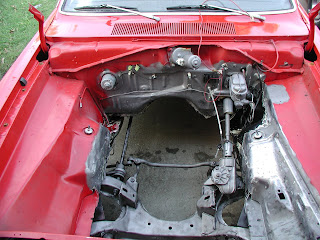
When I began this portion of the project, I really didn't know exactly how I was going to accomplish the task. I began with a general idea and several criteria which had to be met.
- Must fit 14 batteries
- Must use angle iron as I did in the trunk
- Each piece supported by car frame
- Cross pieces must be removable
- No major cutting of car body

It seemed like most of the day was spent thinking, measuring, leveling and calculating. To the left is a picture of the plan I finally came up with. Four batteries will be mounted sideways in the rack down low up front. Ten batteries will then be mounted in the 3 rows of racks above the motor. The angle iron that I have cut will be bolted to supports that I will fabricate and weld to the frame rails.
































